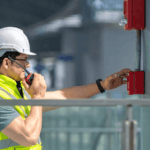
How to engage employees to participate in your EHS program
Implementing a comprehensive safety system may seem daunting, yet the bigger challenge lies in getting employees to fully commit to your safety program.
According to OSHA, “Employee involvement provides the means through which workers develop and express their own commitment to safety and health for both themselves and their fellow workers.”
As safety managers realize that involving employees to carry out more safety responsibilities can significantly reduce the extent and the severity of work-related injuries. There is now a dire need to implement safety management systems that are flexible, easy to engage, and adaptable to the needs of your workforce.

In this blog, we explore the factors that cause the disconnect between your companies safety policies and a disengaged workforce. We will also help you find solutions using digitized workplace safety systems to bridge this gap and motivate employees to get on board your safety program.
Remove cumbersome processes:
If a safety policy is going to add to the workload, workers are bound to cut corners or completely ignore the process.
Engage greater employee participation with a digitized safety system that is customized to the needs of your organization. Ensure that the onboarding process promotes minimal learning and the key processes like reporting an incident or near miss is built intuitively so that employees react impulsively when an emergency arises.
Listen, learn, and act:
Committing to a safety program can only be justified with the management’s willingness to participate, create a culture of open communication, a strong feedback loop, and taking steps to quickly react to employee concerns.
Create an environment where employees can make themselves heard at every opportunity. Conduct constant safety meetings, or establish an incident management software where employee observations can be recorded and conveyed throughout the hierarchy chain to take instant counter-measures.
Reinforce positive behavior:
Analyzing employee behavior is an important intervention strategy to eliminate unsafe behavior. While some unsafe acts may not result in an accident over an elongated period, the natural tendency to continue the unsafe act due to some form of benefit will continue to manifest in our behavior.
A behavior-based system can positively reinforce safe practices by proactively identifying naturally inclined unsafe behavioral patterns in humans and ensuring that timely interventions are in place to encourage individuals or groups to continuously conform to your company’s EHS practices.
Avoid enforcing safety policies
Policing your workforce can create resentment that may sway employees away from actively participating in your safety program. This may also result in dangerous trends such as negative reporting quotas or pushing the blame on other employees.
Instill a culture where employees feel like valued contributors – rewarding them, rather than punishing them with random acts of recognition for their contribution to your safety culture.
The bottom line:
As companies around the world open their doors to newer ways of working, the core objective now is centered on employee safety. Actively engaging employees to spearhead your safety practices could be the key to imbibing a culture that is both safe and productive.
==========
New to EHS management? Learn the meaning of EHS or read our definite guide on EHS Software.
Joshua Martyn was a content manager at Safetymint, crafting helpful contents that enlighten readers and EHS professionals alike, about fresh trends, technologies and perspectives from the world of safety.



